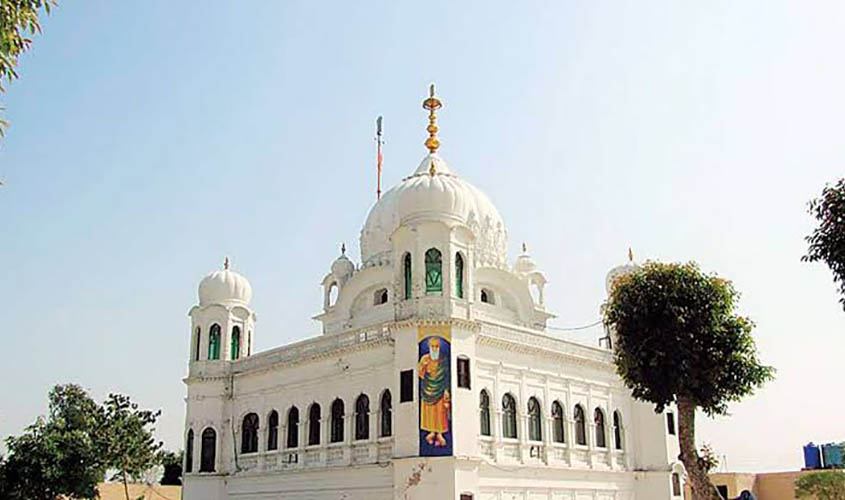First phase of the corridor has been completed, but many have doubts that this will revive the Khalistani movement.
Kartarpur: The Kartarpur corridor was recently inaugurated by Prime Minister Narendra Modi and his Pakistani counterpart Imran Khan to mark the 550th birth anniversary of Guru Nanak Dev, the founder of Sikhism. The corridor connects Dera Baba Nanak shrine in Punjab’s Gurdaspur district with the historic Kartarpur Sahib Gurudwara across the border in Pakistan. In the first-of its-kind occasion in seven decades, Modi sent the first lot of 500 pilgrims to visit Darbar Sahib, also called Kartarpur Sahib, the last resting place of first Sikh Guru Nanak Dev, in Narowal district in Pakistan’s Punjab province. Guru Nanak Dev had spent over 18 years of his life here.
The first batch of pilgrims sent by PM Modi included former Prime Minister Manmohan Singh, Punjab Chief Minister Amarinder Singh, former Chief Minister Parkash Singh Badal, SAD chief Sukhbir Singh Badal and Navjot Singh Sidhu. Modi briefly interacted with Manmohan Singh, who was accompanied by his wife Gursharan Kaur. Modi was received by Chief Minister Amarinder Singh and Union minister Harsimrat Kaur Badal.
The Kartarpur corridor was first proposed in early 1999 by the late Atal Bihari Vajpayee and then Pakistan Prime Minister Nawaz Sharif, as part of the Delhi-Lahore bus diplomacy. Vajpayee had travelled from Amritsar to Lahore in a bus in 1999 and famously hugged Sharif. In 2000, it was reported that General Pervez Musharraf had give the “green light” for constructing the corridor. Unfortunately, it took 20 years to start this corridor. I went to Kartarpur last year when the ground-breaking ceremony took place. The Gurudwara was small, but now it’s a huge complex with white marbles, chandeliers, and eye-catching lights on the tomb. It is a huge complex spread over more than 400 acres; the first phase of the corridor has been completed, now, second phase work will start.
According to Sikh devotees, the Kartarpur corridor will bring peace and unity between India and Pakistan. The main shrine building was built in 1925 at a cost of Rs 1,35,600 donated by Sardar Bhupindar Singh, the Maharaja of Patiala. When Punjab Chief Minister Captain Amarinder Singh’s family visited the Gurudwara, they saw the name plates of Sardar Bhupindar Singh.
With tears in her eyes, Captain Amarinder Singh’s sister said: “I cannot forget this day in my whole life. When I had asked former PM Dr Manmohan Singh’s wife Gursharan whether she thought this corridor would be inaugurated in Dr Singh’s tenure as PM, her answer was jab hona hota hai, tabhi yah hota hai.”
Union minister Harsimrat Kaur Badal said it was her second visit to Kartarpur; last year too, she said, she had visited Kartarpur. “Waahe guru will bring peace between the two nations,” she said.
Before opening of the corridor, the Pakistan government had released a controversial video on the corridor. The video featured pictures of three slain Khalistani separatist leaders. One of the pictures displayed in the video’s background showed Jarnail Singh Bhindranwale, Amrik Singh Khalsa and Major General (Dismissed) Shabeg Singh. All these Khalistani separatist leaders were killed during Operation Blue Star in June 1984. India has strongly condemned this act of Pakistan. Many have doubts that this corridor will revive the Khalistani movement. A day before opening of the corridor, a controversy erupted due to an exhibit put at the Gurudwara site by Pakistani authorities. According to several Indians who were part of a private group that recently visited the Darbar Sahib Gurudwara, Pakistani authorities created an exhibit featuring a small bomb purportedly dropped on the shrine by the Indian Air Force during the 1971 war. The bomb has been placed within a glass case placed atop on a small pillar. A board erected next to the pillar has a description that reads: “Miracle of Waheguruji.”
The board states: “Indian Air Force dropped this bomb during 1971 at Gurdwara Darbar Sahib Sri Kartarpur Sahib with the aim to destroy it. However, this evil design could not materialise due to blessing of Waheguruji (Almighty Allah)…”
When I asked Gurudwara granthi Robin Singh why such boards have been put up, he said: “It’s a miracle of Waheguruji; so it has been put outside the holy shrine.” India has rubbished Pakistan’s claim that the IAF had wanted to destroy the holy place.
Pakistan Foreign Minister Shah Mahmood Qureshi told The Sunday Guardian: “Very soon, we will announce our policy of visa fees and passports.” In the interview, he brought up the Kashmir issue and the Supreme Court’s verdict on the Ram Janambhumi-Babri Masjid case.
Pammi Singh, a Sikh devotee from California, said: “Opening of the Kartarpur corridor will bring peace and harmony between India and Pakistan.”
Simran Sandhu from Canada gave credit to Imran Khan and Navjot Singh Sidhu. According to her, without Sidhu, this corridor could not have been possible.
Another devotee, Jalandhar MLA and former Indian hockey captain Pargat Singh said: “I have played many tournaments in Pakistan. Now, my request to the Pakistan government is to open the route of the Nankana Sahib Gurudwara, the birthplace of Guru Nanak Dev Ji, for Indian Sikhs.”

